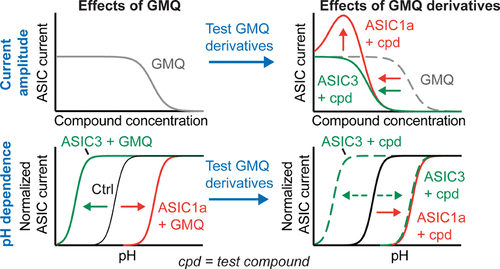当前位置:
X-MOL 学术
›
ACS Chem. Neurosci.
›
论文详情
Our official English website, www.x-mol.net, welcomes your
feedback! (Note: you will need to create a separate account there.)
Heteroarylguanidines as Allosteric Modulators of ASIC1a and ASIC3 Channels
ACS Chemical Neuroscience ( IF 4.1 ) Pub Date : 2018-03-22 00:00:00 , DOI: 10.1021/acschemneuro.7b00529 Omar Alijevic 1 , Hassan Hammoud 2 , Anand Vaithia 1 , Viktor Trendafilov 1 , Maud Bollenbach 2 , Martine Schmitt 2 , Frédéric Bihel 2 , Stephan Kellenberger 1
ACS Chemical Neuroscience ( IF 4.1 ) Pub Date : 2018-03-22 00:00:00 , DOI: 10.1021/acschemneuro.7b00529 Omar Alijevic 1 , Hassan Hammoud 2 , Anand Vaithia 1 , Viktor Trendafilov 1 , Maud Bollenbach 2 , Martine Schmitt 2 , Frédéric Bihel 2 , Stephan Kellenberger 1
Affiliation

|
Acid-sensing ion channels (ASICs) are neuronal Na+-selective ion channels that open in response to extracellular acidification. They are involved in pain, fear, learning, and neurodegeneration after ischemic stroke. 2-Guanidine-4-methylquinazoline (GMQ) was recently discovered as the first nonproton activator of ASIC3. GMQ is of interest as a gating modifier and pore blocker of ASICs. It has however a low potency, and exerts opposite effects on ASIC1a and ASIC3. To further explore the molecular mechanisms of GMQ action, we have used the guanidinium moiety of GMQ as a scaffold and tested the effects of different GMQ derivatives on the ASIC pH dependence and maximal current. We report that GMQ derivatives containing quinazoline and quinoline induced, as GMQ, an alkaline shift of the pH dependence of activation in ASIC3 and an acidic shift in ASIC1a. Another group of 2-guanidinopyridines shifted the pH dependence of both ASIC1a and ASIC3 to more acidic values. Several compounds induced an alkaline shift of the pH dependence of ASIC1a/2a and ASIC2a/3 heteromers. Compared to GMQ, guanidinopyridines showed a 20-fold decrease in the IC50 for ASIC1a and ASIC3 current inhibition at pH 5. Strikingly, 2-guanidino-quinolines and -pyridines showed a concentration-dependent biphasic effect that resulted at higher concentrations in ASIC1a and ASIC3 inhibition (IC50 > 100 μM), while causing at lower concentration a potentiation of ASIC1a, but not ASIC3 currents (EC50 ≈ 10 μM). In conclusion, we describe a new family of small molecules as ASIC ligands and identify an ASIC subtype-specific potentiation by a subgroup of these compounds.
中文翻译:

杂芳基胍作为ASIC1a和ASIC3通道的变构调节剂
酸敏感离子通道(ASICs)是神经元Na +选择性离子通道可响应细胞外酸化而打开。他们参与缺血性中风后的疼痛,恐惧,学习和神经变性。最近发现了2-胍基-4-甲基喹唑啉(GMQ)作为ASIC3的第一个非质子活化剂。GMQ作为门控修饰剂和ASIC的孔封闭剂是令人感兴趣的。然而,它的效能很低,并且对ASIC1a和ASIC3产生相反的影响。为了进一步探索GMQ作用的分子机制,我们使用了GMQ的胍基部分作为支架,并测试了不同GMQ衍生物对ASIC pH依赖性和最大电流的影响。我们报告说,含有喹唑啉和喹啉的GMQ衍生物作为GMQ诱导了ASIC3活化的pH依赖性的碱性转变和ASIC1a的酸性转变。另一组2-胍基吡啶使ASIC1a和ASIC3的pH依赖性变为更酸性。几种化合物引起了ASIC1a / 2a和ASIC2a / 3异聚体的pH依赖性的碱性变化。与GMQ相比,胍基吡啶的IC降低了20倍在pH 5时对ASIC1a和ASIC3的电流抑制作用为50。令人惊讶的是,2-胍基喹啉和-吡啶显示出浓度依赖性的双相效应,导致ASIC1a和ASIC3抑制作用的浓度更高(IC 50 > 100μM),而引起的抑制作用更低。浓度ASIC1a的增强,但不能ASIC3电流(EC 50 ≈10μM)。总之,我们将小分子新家族描述为ASIC配体,并通过这些化合物的亚组确定了ASIC亚型特异性增强。
更新日期:2018-03-22
中文翻译:

杂芳基胍作为ASIC1a和ASIC3通道的变构调节剂
酸敏感离子通道(ASICs)是神经元Na +选择性离子通道可响应细胞外酸化而打开。他们参与缺血性中风后的疼痛,恐惧,学习和神经变性。最近发现了2-胍基-4-甲基喹唑啉(GMQ)作为ASIC3的第一个非质子活化剂。GMQ作为门控修饰剂和ASIC的孔封闭剂是令人感兴趣的。然而,它的效能很低,并且对ASIC1a和ASIC3产生相反的影响。为了进一步探索GMQ作用的分子机制,我们使用了GMQ的胍基部分作为支架,并测试了不同GMQ衍生物对ASIC pH依赖性和最大电流的影响。我们报告说,含有喹唑啉和喹啉的GMQ衍生物作为GMQ诱导了ASIC3活化的pH依赖性的碱性转变和ASIC1a的酸性转变。另一组2-胍基吡啶使ASIC1a和ASIC3的pH依赖性变为更酸性。几种化合物引起了ASIC1a / 2a和ASIC2a / 3异聚体的pH依赖性的碱性变化。与GMQ相比,胍基吡啶的IC降低了20倍在pH 5时对ASIC1a和ASIC3的电流抑制作用为50。令人惊讶的是,2-胍基喹啉和-吡啶显示出浓度依赖性的双相效应,导致ASIC1a和ASIC3抑制作用的浓度更高(IC 50 > 100μM),而引起的抑制作用更低。浓度ASIC1a的增强,但不能ASIC3电流(EC 50 ≈10μM)。总之,我们将小分子新家族描述为ASIC配体,并通过这些化合物的亚组确定了ASIC亚型特异性增强。











































 京公网安备 11010802027423号
京公网安备 11010802027423号